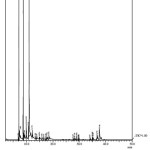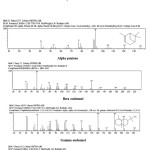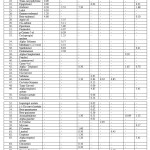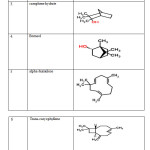A comparative study of the chemical composition of the essential oil from Eucalyptus globulus growing in Dehradun (India) andaround the world.
Archana Joshi1, Ashutosh Sharma1, R. K. Bachheti1* and D. P. Pandey2
1Department of Applied Sciences, Graphic Era University, Dehradun India.
2Department of Chemistry, Govt. P. G. College Uttarkashi, Uttarakhand India.
Corresponding Author E mail: rkbfri@rediffmail.com
DOI : http://dx.doi.org/10.13005/ojc/320137
Article Received on :
Article Accepted on :
Article Published : 04 Mar 2016
Due to increasing use of natural products, essential oil are also in great demand in various field such as pharmaceutical, cosmetic and food industries. The aim of this study is to determine the chemical composition of essential oil of Eucalyptus globulusgrown in Dehradun, India. A total of twenty seven compounds were identified from the essential oil, by Gas chromatography mass spectroscopy representing 100 % of the total oil.The dominant compounds being Eucalyptol (1,8-cineole) 54.79 %, β- pinene 18.54 % α- pinene 11.46 %, β- eudesmol 4.68%, α-phellandrene 2.06% Para cymene 1.60% and Gamma- eudesmol 1.20%. Comparison of the literature on essential oil from Eucalyptus globulusaround the world (seven countries) suggested eight compounds that were uniquely present only in Dehradun essential oil sample. Thus, the present study suggested that Eucalyptus globulusgrowing in Dehradun contains several volatile compounds that are not reported in other Eucalyptus globulus essential oil around the world.
KEYWORDS:Eucalyptus globulus; chemical composition; comparison
Download this article as:| Copy the following to cite this article: Joshi A, Sharma A, Bachheti R. K, Pandey D. P. A comparative study of the chemical composition of the essential oil from Eucalyptus globulus growing in Dehradun (India) andaround the world. Orient J Chem 2016;32(1). |
| Copy the following to cite this URL: Joshi A, Sharma A, Bachheti R. K, Pandey D. P. A comparative study of the chemical composition of the essential oil from Eucalyptus globulus growing in Dehradun (India) andaround the world. Orient J Chem 2016;32(1). Available from: http://www.orientjchem.org/?p=14672 |
Introduction
Due to awareness regarding the use of synthetic additives, people are now using natural essential oil in the various field such as food, drinks, toiletries and cosmetics [1]. Many reports available which shows the use of essential oil in food, pharmaceutical, aromatherapy, perfumes, antibacterial-antifungal agents, and to repel insect or protect stored products [2-5]. Plant essential oils are obtained from non-woody parts of the plant, particularly foliage, through steam or hydrodistillation. Main components of essential oil are hydrocarbons, aromatic derivatives, terpenes and their oxygenated derivatives (mono- and sesqui-terpenoids, alcohols and esters) [6,7]. Essential oil has been cultivated for medicinal oil production in many parts of the world. Numbers of reports are available all around the world which shows the antibacterial [8-11]and antioxidant of EucalyptusLeaves.[12-16]. Eucalyptus essential oil is extracted from Eucalyptus globulusof the Myrtaceae family and is also known as Tasmanian blue gum or blue gum. There are over 500 species of Eucalyptus trees, with tough long and narrow blue-green leaves, creamy white flowers and smooth pale bark [17].
Eucalyptus has a long history in India. It was first planted around 1790 by Tippu Sultan, the ruler of Mysore, in his palace garden on Nandi hills near Bangalore. According to one version he received seed from Australia and introduced about 16 species [18]. In India there are number of Eucalptus species available such as E. tereticornis,E. grandis, E. citriodora, E. globulus, and E. camaldulensis.There are various studies available on chemical composition and antimicrobial activity of essential oil of Eucalyptus of Indian origin [19,20] but to the best of my knowledge, no report is available on the chemical constituents of Eucalyptus globulus leave essential oil grown in Dehradun, India.
Materials and Methods
Plant Material:
Leaves of Eucalyptus globulus were collected from Dehradun in the month of September, 2013. The species were identified by Dr. Sumer Chand Ex Scientist in Forest Research Institute (FRI) Dehradu
n, India.
Description of the study area
Dehradun is one of the oldest cities of Uttaranchal, situated in the foothills of the Great Himalayas. This is one of the 13 administrative districts of the state and is important for tourism point of view. The district is surrounded by the Himalayan Mountains in the north, Shivalik hills in the south, the river Ganga in the east, and the river Yamuna in the west. The two pristine rivers Ganga and Yamuna pass through the district.
The geographical area of the district is 3088.00 sq. kms, lies between 30.19° N latitude and 78.04° E longitude. Average rainfall in the district is about 2073.3 mm.
Extraction of essential oil
Freshly collected 100 g leaves were weighed and hydrodistilled for four hours for complete extraction of essential oil, using a commercial Clevenger-type apparatus. The oil sample obtained from hydrodistillation was freed from moisture by adding anhydrous sodium sulfate and an absolute oil sample was obtained.
Percentage yield of Oil
The amount of extracted oil was determined and yield% of the extracted oil from each sample on the basis of various eucalyptus leaves samples by using following formula:

GC-MS Analysis of Essential oil
The essential oil from leaves of Eucalyptus globulus was analyzed on GC-MS QP-2010 Plus (ShimadzuCompany) using HP-5 MS column (30 m x 0.25 mm internal diameter x 0.25 μm film thickness) which was coated by 5% phenyl 95% methyl poly siloxane stationary. The syringe was washed with 8 μL of chloroform and 2 μL essential oil solution in chloroform was injected through autosampler and analyzed with HP5 MS column.Column temperature was programmed as follows: 50 to 120 °C at 20, 120 to 150 °C at 4 °C/min, 150 to 250 °C at 20 oC/min (10 min hold time) and 3.5 min solvent delay. The temperature of the injector was fixed to 260 °C and the detector (FID) to 270 °C. Carrier gas was helium (1 mL/min) with 69.8 kPa and a split ratio of 100:1. The interface temperature was 280 °C. The mass spectra were recorded in electron ionization mode at 70 eV with scanning from 40 to 600 m/z at 0.5 s and ion source temperature was set at 230 °C. The percentage of each constituent in the oil was determined based on GC peak areas. The constituents of essential oil were identified by their retention index, MS Library search (NIST 08 and WILEY 8 libraries) and by comparison with the spectra and retention index data in the literature.
 |
Figure 1: GC-MS chromatogram of Eucalyptus Globulusessential oil |
 |
Figure 2: Mass spectrum(m/z)of major components present in Eucalyptus globulusessential oil with peak report |
 |
Table 1: Chemical composition of essential oil from Eucalyptus globulus(fresh leaves) from various Countries around the world |
Results and Discussion
Hydrodistillation of the E. globulus leaves yielded 1.1% of essential oil (w/w, based on the fresh weight of the mature leaves). There are many literature reported for E. globulus where the essential oil yield was 1.9–2.7% (w/w, based on the fresh weight of the young leaves) in Morocco [21], 2.68% (w/w, based on the fresh weight of the adult leaves) in Argentina [22], and1.05% in India [8].
The chemical composition of the E. globulus essential oil (Dehradun) is shown in Table 1. GC-MS analyses revealed the presence of twenty seven compounds representing 100 % of the total oil.In these 27 compounds, some are sesquiterpenes, monoterpenes, oxygenated monoterpenes and oxygenated sesquiterpenes respectively. Eucalyptol (1,8- cineole) (54.79%), beta-pinene (18.54%), alpha-pinene (11.46%), beta-eudesmol (4.68%), alpha-phellandrene (2.06%), para-cymene (1.60%) and gamma-eudesmol (1.20%) are the main components (Table 1). Beta-eudesmol suppresses tumour growth through inhibition of tumour neovascularisation and tumour cell proliferation[23].
Table 1 shows the list of different compounds obtained in the essential oil of E. globulusand compared to the previous results of the different countries. The list shows that eucalyptol percentage is maximum in Montengro (85.82%) and minimum in Tunsia (43.18%). Variation in chemical composition is due to different environmental, agronomic factors. The age and geoclimatic factors also effect the chemical composition of essential oil [23]. Beta-eudesmol is present only in essential oil of two countries- India 4.68% and Ethiopia 0.10%. Hence essential oil obtained from Dehradun can be a good source of Beta-eudesmol.
Table 1 also shows that there are 6 unique compounds in present study (Dehradun). These unique compounds are alpha-fenchyl alcohol (0.27%), borneol (0.27%), alpha-humulene (0.07%), trans-caryophyllene (0.09%), ledol (0.03%) and gamma-eudesmol (1.20%) respectively.
 |
Table 2: Compounds present uniquely inE. globulus essential oil (Dehradun sample) Click here to View table |
The dominant compounds being Eucalyptol (1,8-cineole) 54.79 is the major component in all essential oil of all countries presented in table 1.Eucalyptol (1-8 cineole) is a cyclic ether with empirical formula C10H18O and systematic name 1,3,3-trimethyl-2-oxabicyclo[2.2.2]octane. It is sometimes traded commercially as “eucalyptol”.Cineole determines the commercial value of the oil and its importance as a raw material for different industries. Different percentages of 1,8-cineole in E. globulus leaf oil have been reported: 64.5% in Uruguay, 77% in Cuba, 86.7% in California, 58% to 82% in Morocco, 48.7% in Africa, and 50% to 65% in Argentina [22]. Alpha-pinene is present in essential oil of all countries but the percentage varies from place to place. Highest percentage of alpha-pinene (24.60 %) in Algeria followed by Ethiopia (23.79 %). Least % of alpha-pinene is present in Nigeria (4.16 %). Alpha-pinene is a component of many essential oiland has anti-inflammatory and antimicrobial properties [24].
Conclusion
This study has shown that essential oil of Eucalyptus globulus grown in Dehradun, India possesses rather a good amount of eucalyptol (1,8-Cineole) which determine the commercial value of oil. Beta-eudesmol is present in highest amount in Dehradun essential oil which is absent in all other countries except Ethiopia. Eight components are uniquely present in essential oil of Dehradun. This study has precisely compared essential oil components from Eucalyptus globulus fresh leaves, around the globe. Further, studies with purified major compounds, either as single entities or in combinations would pave way for better understanding of the functionalities associated with various bioactivities.
References
- Sacchetti, G.;Maietti, S.;Muzzoli, M.;Scaglianti. M.;Manfredini, S.;Radice, M.;Bruni, R. Food Chemistry 2005,91, 621–632.
CrossRef - Hassani,A. A.;International Letters of Chemistry, Physics and Astronomy 2013,9,17-24.
- Boukhatem, M. N.;Kameli, A.;Saidi, F.Food Control2013, 34(1), 208-213.
CrossRef - Edris, E.;Phytotherapy Research2007, 21(4), 308-323.
CrossRef - Bakkali, F.;Averbeck,S.;Idaomar,M.Food and Chemical Toxicology 2008, 46(2), 446-475.
CrossRef - Bremness, L. Herbs. Dorling Kindersley, London, 2000, 54.
- Baratta, M.T.; Dorman, H. J.; Deans, S. G.;Figueiredo, A. C.; Barroso, J. G.;Ruperto, G. Flavour and Fragrance Journal1998,13, 235–244.
CrossRef - Bachheti,R. K.; Joshi, A.; Singh,A. International Journal of ChemTech Research, 2011,3(2), 625-628.
- Elaissi,A.; Salah, K.H.;Mabrouk,S.;Larbi,M.K.;Chemli, R.; Skhiri,F.H.Food Chemistry, 2011, 129, 1427–1434.
CrossRef - Gilles, M.; Zhao,J.;Agboola, M. An. M.Food Chemistry, 2010, 119, 731–737.
CrossRef - Bachheti, R. K. Der PharmaChemica, 2015, 7(2), 209-214.
- Marzoug, H. N. B.;Romdhane, M.; Lebrihi, A.; Mathieu, F.;Couderc, F.;Abderraba, M,; KhoujaM. L.; Bouajila,J.Molecules, 2011, 16, 1695-1709.
CrossRef - Barra, A.;Coroneo, V.;Dessi, S.; Cabras, S.;Angioni,A.Nat Prod Commun. 2010, 5(2), 329-35.
- Sulaiman,G.M.; Marzoog,T.R.; Mohammed, W.H.;Bagnati,R.American Journal of Agricultural and Biological Sciences, 2014, 9 (1),78-88.
CrossRef - Nasrabadi, M.R.; Pourmortazavi,S.M.;Nazarian, S.; Ahmadi F.;Batooli, International Journal of Food Properties,2013, 16 (5), 1080-1091.
- Madouri, L. H.;Asma, B.;Madani, K.; Ould, Z. B.; Said,Si.; Rigou, P,; Grenier, D.;Allalou, H.;Remini, H.; Adjaoud, A.;Makhlouf. L. B.Industrial Crops and Products,2015,78 148–153.
- Coppen, J. J. CRC Press 2003, 112-145.
- Sundar, S. S. Forest Development and Eucalyptus controversy in Karnataka, Workshop on Eucalyptus plantation, Indian Statistical Institute, Bangalore.1984.
- Joshi,R. K. Aroma profile of Eucalyptus globulus: collected from northwest Karnataka, India Scientific World, 2012,10, (10), 89-90.
CrossRef - Tyagi, A. K.; Malik, A.Food Chemistry2011, 126 (1), 228-235.
CrossRef - Zira, S. S.; Benjilali,B.B. Journal of Essential Oil Research, 1996, 8, 19–24.
CrossRef - Viturro,C.I. Journal of Essential Oil Research, 2003, 15, 206–208.
CrossRef - El, M.; Yc, L.;Tsuneki, H.; Xiao, J. F,; Xia M,; Wang M. W,; Kimura.J Asian Nat. Prod. Res., 2008, 10 (1-2): 159-67.
- http://www.wisegeekhealth.com/what-are-the-medical-uses-of-alpha-pinene.htm

This work is licensed under a Creative Commons Attribution 4.0 International License.









